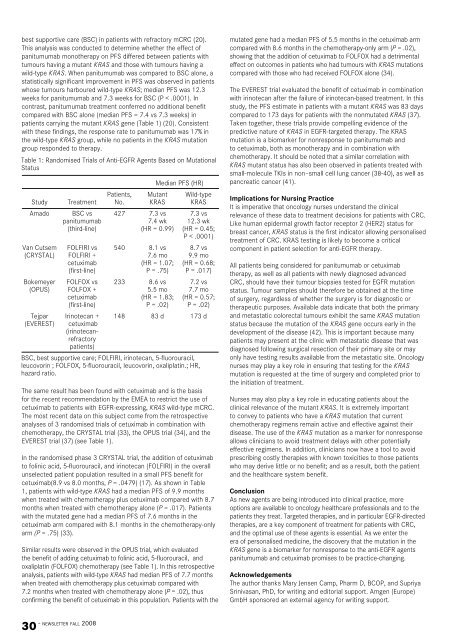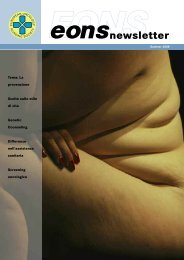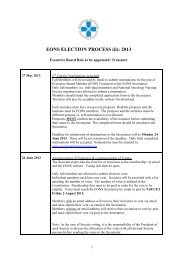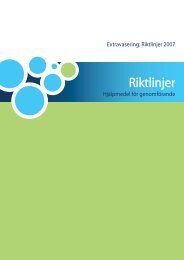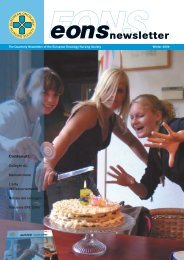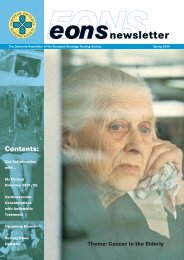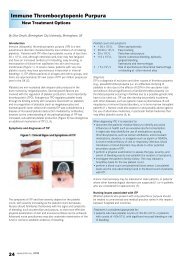English - the European Oncology Nursing Society
English - the European Oncology Nursing Society
English - the European Oncology Nursing Society
- No tags were found...
You also want an ePaper? Increase the reach of your titles
YUMPU automatically turns print PDFs into web optimized ePapers that Google loves.
mutated gene had a median PFS of 5.5 months in <strong>the</strong> cetuximab armbest supportive care (BSC) in patients with refractory mCRC (20).30 - newsletter fall 2008This analysis was conducted to determine whe<strong>the</strong>r <strong>the</strong> effect ofpanitumumab mono<strong>the</strong>rapy on PFS differed between patients withtumours having a mutant KRAS and those with tumours having awild-type KRAS. When panitumumab was compared to BSC alone, acompared with 8.6 months in <strong>the</strong> chemo<strong>the</strong>rapy-only arm (P = .02),showing that <strong>the</strong> addition of cetuximab to FOLFOX had a detrimentaleffect on outcomes in patients who had tumours with KRAS mutationscompared with those who had received FOLFOX alone (34).statistically significant improvement in PFS was observed in patientswhose tumours harboured wild-type KRAS; median PFS was 12.3weeks for panitumumab and 7.3 weeks for BSC (P < .0001). Incontrast, panitumumab treatment conferred no additional benefitcompared with BSC alone (median PFS = 7.4 vs 7.3 weeks) inpatients carrying <strong>the</strong> mutant KRAS gene (Table 1) (20). Consistentwith <strong>the</strong>se findings, <strong>the</strong> response rate to panitumumab was 17% in<strong>the</strong> wild-type KRAS group, while no patients in <strong>the</strong> KRAS mutationgroup responded to <strong>the</strong>rapy.The EVEREST trial evaluated <strong>the</strong> benefit of cetuximab in combinationwith irinotecan after <strong>the</strong> failure of irinotecan-based treatment. In thisstudy, <strong>the</strong> PFS estimate in patients with a mutant KRAS was 83 dayscompared to 173 days for patients with <strong>the</strong> nonmutated KRAS (37).Taken toge<strong>the</strong>r, <strong>the</strong>se trials provide compelling evidence of <strong>the</strong>predictive nature of KRAS in EGFR-targeted <strong>the</strong>rapy. The KRASmutation is a biomarker for nonresponse to panitumumab andto cetuximab, both as mono<strong>the</strong>rapy and in combination withTable 1: Randomised Trials of Anti-EGFR Agents Based on Mutationalchemo<strong>the</strong>rapy. It should be noted that a similar correlation withStatusKRAS mutant status has also been observed in patients treated withsmall-molecule TKIs in non–small cell lung cancer (38-40), as well asMedian PFS (HR) pancreatic cancer (41).Patients, Mutant Wild-typeStudy Treatment No. KRAS KRASImplications for <strong>Nursing</strong> PracticeIt is imperative that oncology nurses understand <strong>the</strong> clinicalAmado BSC vs 427 7.3 vs 7.3 vs relevance of <strong>the</strong>se data to treatment decisions for patients with CRC.panitumumab 7.4 wk 12.3 wk Like human epidermal growth factor receptor 2 (HER2) status for(third-line) (HR = 0.99) (HR = 0.45;breast cancer, KRAS status is <strong>the</strong> first indicator allowing personalisedP < .0001)treatment of CRC. KRAS testing is likely to become a criticalVan Cutsem FOLFIRI vs 540 8.1 vs 8.7 vs(CRYSTAL) FOLFIRI + 7.6 mo 9.9 mocomponent in patient selection for anti-EGFR <strong>the</strong>rapy.All patients being considered for panitumumab or cetuximab<strong>the</strong>rapy, as well as all patients with newly diagnosed advancedcetuximab(first-line)(HR = 1.07;P = .75)(HR = 0.68;P = .017)Bokemeyer FOLFOX vs 233 8.6 vs 7.2 vs CRC, should have <strong>the</strong>ir tumour biopsies tested for EGFR mutation(OPUS) FOLFOX + 5.5 mo 7.7 mo status. Tumour samples should <strong>the</strong>refore be obtained at <strong>the</strong> timecetuximab (HR = 1.83; (HR = 0.57; of surgery, regardless of whe<strong>the</strong>r <strong>the</strong> surgery is for diagnostic or(first-line) P = .02) P = .02) <strong>the</strong>rapeutic purposes. Available data indicate that both <strong>the</strong> primaryTejpar Irinotecan + 148 83 d 173 d and metastatic colorectal tumours exhibit <strong>the</strong> same KRAS mutation(EVEREST) cetuximabstatus because <strong>the</strong> mutation of <strong>the</strong> KRAS gene occurs early in <strong>the</strong>(irinotecanrefractorypatients may present at <strong>the</strong> clinic with metastatic disease that wasdevelopment of <strong>the</strong> disease (42). This is important because manypatients)diagnosed following surgical resection of <strong>the</strong>ir primary site or mayBSC, best supportive care; FOLFIRI, irinotecan, 5-fluorouracil,leucovorin ; FOLFOX, 5-fluorouracil, leucovorin, oxaliplatin.; HR,hazard ratio.only have testing results available from <strong>the</strong> metastatic site. <strong>Oncology</strong>nurses may play a key role in ensuring that testing for <strong>the</strong> KRASmutation is requested at <strong>the</strong> time of surgery and completed prior to<strong>the</strong> initiation of treatment.The same result has been found with cetuximab and is <strong>the</strong> basisfor <strong>the</strong> recent recommendation by <strong>the</strong> EMEA to restrict <strong>the</strong> use ofcetuximab to patients with EGFR-expressing, KRAS wild-type mCRC.The most recent data on this subject come from <strong>the</strong> retrospectiveanalyses of 3 randomised trials of cetuximab in combination withchemo<strong>the</strong>rapy, <strong>the</strong> CRYSTAL trial (33), <strong>the</strong> OPUS trial (34), and <strong>the</strong>EVEREST trial (37) (see Table 1).Nurses may also play a key role in educating patients about <strong>the</strong>clinical relevance of <strong>the</strong> mutant KRAS. It is extremely importantto convey to patients who have a KRAS mutation that currentchemo<strong>the</strong>rapy regimens remain active and effective against <strong>the</strong>irdisease. The use of <strong>the</strong> KRAS mutation as a marker for nonresponseallows clinicians to avoid treatment delays with o<strong>the</strong>r potentiallyeffective regimens. In addition, clinicians now have a tool to avoidIn <strong>the</strong> randomised phase 3 CRYSTAL trial, <strong>the</strong> addition of cetuximabto folinic acid, 5-fluorouracil, and irinotecan (FOLFIRI) in <strong>the</strong> overallunselected patient population resulted in a small PFS benefit forprescribing costly <strong>the</strong>rapies with known toxicities to those patientswho may derive little or no benefit; and as a result, both <strong>the</strong> patientand <strong>the</strong> healthcare system benefit.cetuximab(8.9 vs 8.0 months, P = .0479) (17). As shown in Table1, patients with wild-type KRAS had a median PFS of 9.9 monthswhen treated with chemo<strong>the</strong>rapy plus cetuximab compared with 8.7months when treated with chemo<strong>the</strong>rapy alone (P = .017). Patientswith <strong>the</strong> mutated gene had a median PFS of 7.6 months in <strong>the</strong>cetuximab arm compared with 8.1 months in <strong>the</strong> chemo<strong>the</strong>rapy-onlyarm (P = .75) (33).ConclusionAs new agents are being introduced into clinical practice, moreoptions are available to oncology healthcare professionals and to <strong>the</strong>patients <strong>the</strong>y treat. Targeted <strong>the</strong>rapies, and in particular EGFR-directed<strong>the</strong>rapies, are a key component of treatment for patients with CRC,and <strong>the</strong> optimal use of <strong>the</strong>se agents is essential. As we enter <strong>the</strong>era of personalised medicine, <strong>the</strong> discovery that <strong>the</strong> mutation in <strong>the</strong>Similar results were observed in <strong>the</strong> OPUS trial, which evaluated<strong>the</strong> benefit of adding cetuximab to folinic acid, 5-fluorouracil, andKRAS gene is a biomarker for nonresponse to <strong>the</strong> anti-EGFR agentspanitumumab and cetuximab promises to be practice-changing.oxaliplatin (FOLFOX) chemo<strong>the</strong>rapy (see Table 1). In this retrospectiveanalysis, patients with wild-type KRAS had median PFS of 7.7 monthswhen treated with chemo<strong>the</strong>rapy plus cetuximab compared with7.2 months when treated with chemo<strong>the</strong>rapy alone (P = .02), thusconfirming <strong>the</strong> benefit of cetuximab in this population. Patients with <strong>the</strong>AcknowledgementsThe author thanks Mary Jensen Camp, Pharm D, BCOP, and SupriyaSrinivasan, PhD, for writing and editorial support. Amgen (Europe)GmbH sponsored an external agency for writing support.


